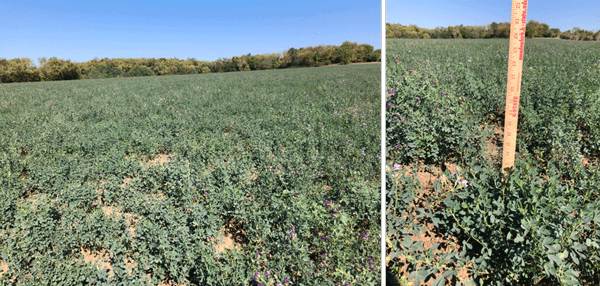A recent eUpdate article from early September discussed the best time for the last cuttings of alfalfa ahead of the winter months (https://bit.ly/3P7QIk4). The decision should be weather-based at this time of the year because the timing of the last two cuttings impacts the winter survival and productivity of the stand in the following year.
This article answers some questions related to the last cutting for stands that are shorter than normal or are under drought stress (Figure 1).
- What if the alfalfa stand is short (less than 12 inches)?
In this case, the recommendation would be to avoid cutting it as the alfalfa tonnage would likely be low enough, not justifying costs. Additionally, avoiding cutting a short stand of alfalfa if there is insufficient growth to warrant harvesting from an economic standpoint actually helps the stand. This decision may also depend on stand thickness, but there should be about 12 to 15 inches of plant height to warrant harvesting. If there isn’t that much growth, wait for sufficient second growth once rainfall is received.

Figure 1. Alfalfa field in northeast Kansas (Jefferson County) with reduced stand height. Photos by David Hallauer, K-State Research and Extension.
- What are the best management options for drought-stressed alfalfa stands?
- Is it too late to cut a stand now, assuming there won’t be a hard freeze until November?
Always use caution when harvesting alfalfa in the fall, especially if the plant is already drought-stressed. Cutting the crop without leaving 6-8 weeks of re-growth before the first freeze can damage the stand and reduce persistence for subsequent years. Here, growers should base the anticipated timing of the freeze event on the average freeze date for their location and not count with a later date. Thus, if the crop is currently drought-stressed, the most appropriate management would be to wait until a good hard freeze and then harvest it. If yield is limiting enough not to cover harvest costs later in the fall, an option would be to graze after a hard freeze event. These measures would give the stand the best possible situation going into the fall. That way, you will have a good stand and (hopefully) precipitation to work with the next year.
Romulo Lollato, Wheat and Forage Specialist
lollato@ksu.edu
John Holman, Cropping Systems Agronomist – Garden City
jholman@ksu.edu